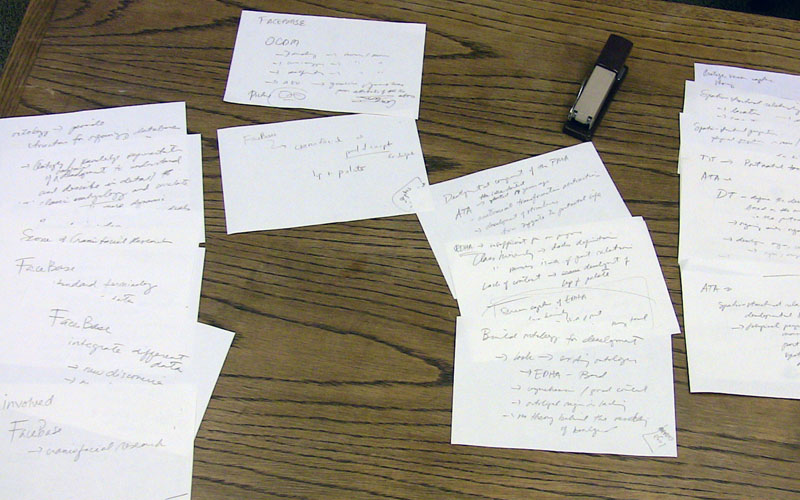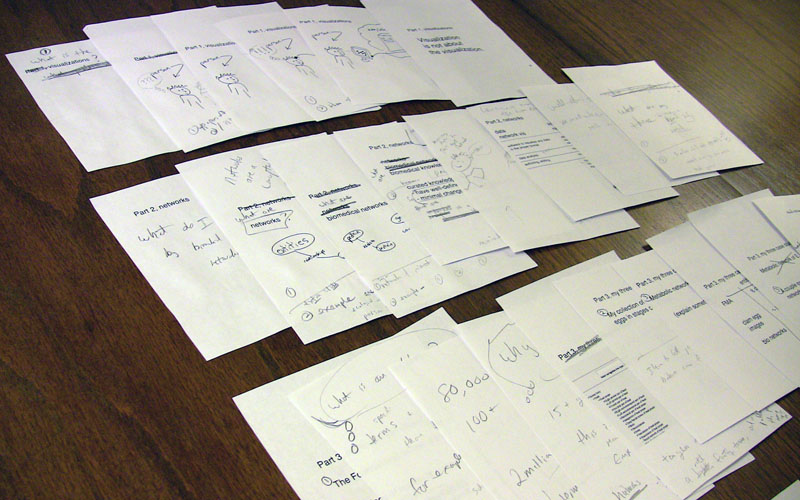Using a Storyboard to Plan a Presentation
Published on October 30, 2015
Think about the last time you began to prepare a formal presentation for a group. There is a good chance the presentation included slides. If you were not reusing an old set of slides, you probably opened up PowerPoint or Keynote, picked a template, and began creating slide content. I would like suggest a different approach to designing a presentation: creating a storyboard.
Storyboarding is a technique for developing the structure and content of a presentation. Once you have identified your audience, purpose, and context, you are ready to begin storyboarding.
The method:
Storyboarding requires only a pencil and 20–30 pieces of paper. I often use sheets of printer paper cut in half.
Write down one idea or concept per sheet of paper. (Don’t think of the pieces of paper as slides. They are only chunks of information.) Quickly produce these “chunks” to reflect the presentation you are imagining. Then begin arranging and grouping the pieces of paper. Do you have a logical structure with an introduction, 2–4 sections in the body, and a conclusion? Does everything support the purpose of your presentation? What do you need to add or remove?
Allow at least an hour for this process. You might want to put away your storyboard and then come back to it in a few days.
Once you are satisfied with your plan, it is a great time to get feedback. Find people who represent your audience and explain the storyboard to them. Are there any pieces that don’t seem to fit? Any important information you are forgetting to include? Is the purpose clear? Is it interesting? People will be more willing to give you honest feedback at this stage—rather than after you have made slides—because changes can easily be made.
Here are two examples of storyboards:
 Figure 1: Storyboard made by my colleague for a conference presentation
Figure 1: Storyboard made by my colleague for a conference presentation
 Figure 2: For this storyboard I first typed some content and then printed it out
Figure 2: For this storyboard I first typed some content and then printed it out
Once you have developed your storyboard, it is time to think about how to present this information. Consider how will you integrate what you say with what you show on the slides. Do you need to create or collect any images? Can you use sentence headers? Once you are thinking about these questions it is time to open your slide presentation software.
Why storyboarding is helpful:
In addition to providing an opportunity for early feedback, storyboarding has several advantages:
It allows you to quickly examine the structure of what you are developing and to rearrange, add, and remove pieces.
It is an opportunity to get away from your computer and to focus on a single task. Because you don’t need any equipment other than a pencil and paper, you can do this activity nearly anywhere.
If you tend to procrastinate when developing presentations, this method may help you to begin earlier. Because a storyboard is only a preliminary plan and does not have to be perfect, it is less stressful to begin. And because the planning phase is separated from the slide-making phase, you can do this phase early and then make the slides later.
 |
About the author: Melissa Clarkson is a researcher, information designer, and educator working at the intersection of informatics, design, and life sciences. She is a graduate of the PhD program in Biomedical and Health Informatics at the University of Washington. Her masters training in design was at Carnegie Mellon University, and she has also received a MA in Molecular, Cellular, and Developmental Biology from the University of Kansas. Her research focuses on how to clearly communicate complex and technical information. In her role as an educator she teaches visual communication skills to scientists and engineers. Her portfolio is available at melissaclarkson.com |

